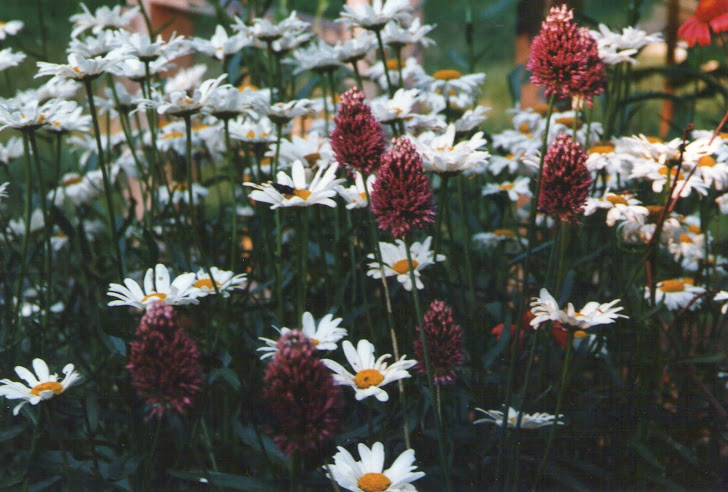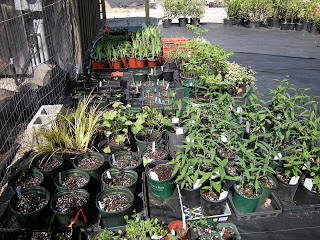*Don't forget to click on photos to view full-size!
" But each Spring...a gardening instinct, sure as the sap rising in the trees, stirs within us. We look about and decide to tame another little bit of ground..." Lewis Gantt
I LOVE ROCKS! They are such a cool garden feature. Like hostas they come in an array of sizes, shapes, colors and textures. Rocks add substance to vignettes of plants, water, sky and man-made objects. People are sometimes called "rocks" meaning they are strong and have integrity, can always be counted on. So I LOVE ROCKS!

The problem is we live in Burrillville (or Boulderville as I sometimes (affectionately?) call it. Every time that instinct to tame a bit of ground stirs in me, my shovel hits a rock. I'm working on an area of garden at the back where Black Hut Management Area borders our property. Tree roots, wild blackberry thorns, and trash, dumped back in the pre-garbage-pick-up days, make gardening difficult. (We've actually found some interesting stuff buried back there ...a topic for another day.) Nothing is more challenging than the rocks. Often after struggling for 1/2 an hour to remove a rock of indeterminate size, I'll give Paul a "hey! can you see if this rock is movable?" Sometimes he wiggles it with a shovel and says "yeah, you can get that out", more often he rises to the challenge and pits himself against that giant rock (or several dozen smaller rocks apparently glued together by time) and eventually (
usually) makes room for some soil.
 |
| A work in progress... |
Then the question is, What do we do with the rock? "I'm not moving that!" he'll sigh as we look at the behemoth from beneath, now sitting on top of the ground. We've ended up with piles of rocks scattered among our garden rooms owing to my reply, "Let's just roll it over here, that looks perfect!"
In short, we've used rocks as borders, focal points, textural elements or mulch in every part of our garden, and about 90% of those rocks we dug up so we could tame a little bit more ground.
 |
| Rocks around the pond garden. |
 |
| Rocks around the shed garden. |
 |
| Piles of rocks are interesting. |
 |
I had laid out the area I wanted for a new bed, uncovered this gorgeous granite gargantuan buried right under the surface, and quickly decided to work around it.
Note: It's so hard to photograph a garden in Spring! Buckets and tools here and there, piles of compost, manure, and mulch! No sense in cleaning up, you'll just make another mess tomorrow. I put the cardboard you see in the photos down in the paths last Fall. It's probably a good thing because I'm sure a lot of weed seeds survived our Winter-That-Wasn't. The paths will be covered with mulch....soon I hope!
& Quotes Years ago I was reading one of my many favorite garden magazines and came across a quote that touched me and stuck: The very best fertilizer is the gardener's own footprints. To me it meant simply that the most important thing you can do for your garden is Be In It and Pay Attention...a daily walk through your garden, noting potential problems, discovering little successes and surprises, bending over and pulling a weed here and there as you go, will achieve more than anything money can buy. When I decided to start my business (Green Sneakers Garden) I did a little research and found that the quote is probably a paraphrase of The best fertilizer for a piece of land is the footprints of its owner..(Lyndon B. Johnson American President). We heard Roger Swain (our garden guru) speak at the Flower Show and he, too, had a variation: The best fertilizer is the shadow of the gardener.
So you'll have to excuse me til next week. Sun's almost up and I need to cast a shadow and leave some footprints in my garden. Happy Gardening!
Coming next week: The root that ate the front yard! Just kidding!
Note: It's estimated that there are more than 250,000 miles of stone wall in the northeast. The rocks used to make these walls were produced between 150,000 and 15,000 years ago and deposited (mostly in New England it seems) when the last ice sheets melted. Recently many of these historic stone walls have been pulled apart and shipped to make new walls in other parts of the country. The destruction of these walls is lamentable. They are a part of our history and culture. The wildlife habitat provided by these walls for hundreds of years is also being lost. To learn more go to: www.stonewall.uconn.edu
|
 Their tasks include extensive fact finding using plant info cards and a hefty volume or two. Each plant is then labeled with the information needed to aid in deciding to buy and plant it right.
Their tasks include extensive fact finding using plant info cards and a hefty volume or two. Each plant is then labeled with the information needed to aid in deciding to buy and plant it right. And of course, WATERING! The Rhode Island Wild Plant Society is dedicated to studying, protecting, and cultivating appreciation for native plants and habitats. You can visit their website at www.RIWPS,org . So plan to visit URI's East Farm Spring Festival on May 12 and buy a native plant (or 2) from RIWPS. I'm sure that's just what mom wants for Mother's Day on Sunday. I know I do!
And of course, WATERING! The Rhode Island Wild Plant Society is dedicated to studying, protecting, and cultivating appreciation for native plants and habitats. You can visit their website at www.RIWPS,org . So plan to visit URI's East Farm Spring Festival on May 12 and buy a native plant (or 2) from RIWPS. I'm sure that's just what mom wants for Mother's Day on Sunday. I know I do!

































